
Modern online technology has made booking trips from tour operators nice and easy. Just in a few clicks one can easily select and book the journey of a lifetime from a sleek and user-friendly travel website – a must-have for any ambitious modern tour operator. Travel websites are quite complex solutions in themselves and require quite an effort to build by a team of professionals – web designers, front-end developers, HTML editors and more. However, whenever you look beyond the front-end you’ll realize – what you’ve seen is just the tip of the iceberg.
Modern tour operator platforms are sophisticated systems covering a multitude of activities performed by tour operators on a daily basis and invisible to the end-user. Most of these activities are handled by back-office applications. They are extremely complex and intertwined. It may be quite difficult to grasp the logic behind them on your own.
We decided to create this article to take you on a guided tour behind the scenes and present a modern tour operator back-office to you in a digestible and clear fashion. We’ll also dig deeper into modern development trends and some noteworthy setup peculiarities.
Let’s go!
Back-office is the key part of tour operator software responsible for all-round business process automation. It contains a wide set of apps, modules and tools each contributing to their own part of the common cause which is tour operator business.
Here is a simplified scheme presenting the structure of modern tour operator back-office:
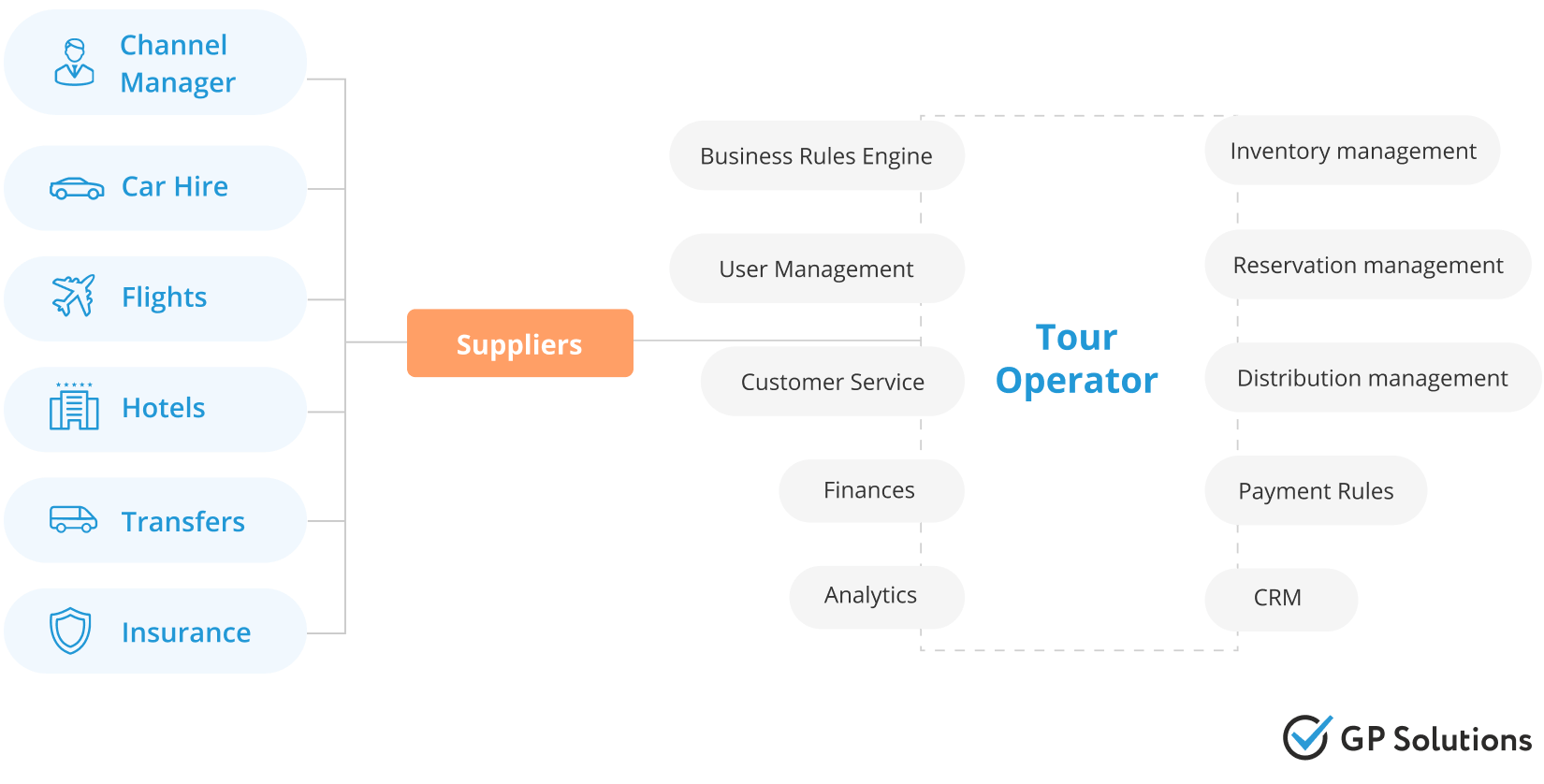
Even this simplified version may appear quite bulky. But it is just the beginning of the journey. Every element of the scheme hides a world of its own specific functionality. Let us dig a bit deeper into each building block and deal with it in more detail.
This is a key building block responsible for storing and managing all content related to travel products offered by a tour operator to its clients and partners. The content may include short and extended descriptions, media files, available services, pricing conditions, and much more. Inventory is also responsible for availability management, whereby tour operators define, for ex., how many rooms, tickets, boarding places are available for the given product over the given period of time.
Modern travel inventory is typically filled in 3 basic ways:
Manually via CMS(self-operated inventory) – tour operator employees input by hand the data about the products sold by tour operator;
Via automated API connectivity – a back-office system is connected to various 3rd-party travel supplier APIs to receive information on product availability in real time.
Via Extranet – this is the option for suppliers who don’t have their own API for automated integration. In this scenario case supplier employees receive access credentials to the back-office to create and manage their products manually.
We didn’t put inventory first by chance. It is at the heart of tour operator activity, being the unified source of all products offered to the end customer.
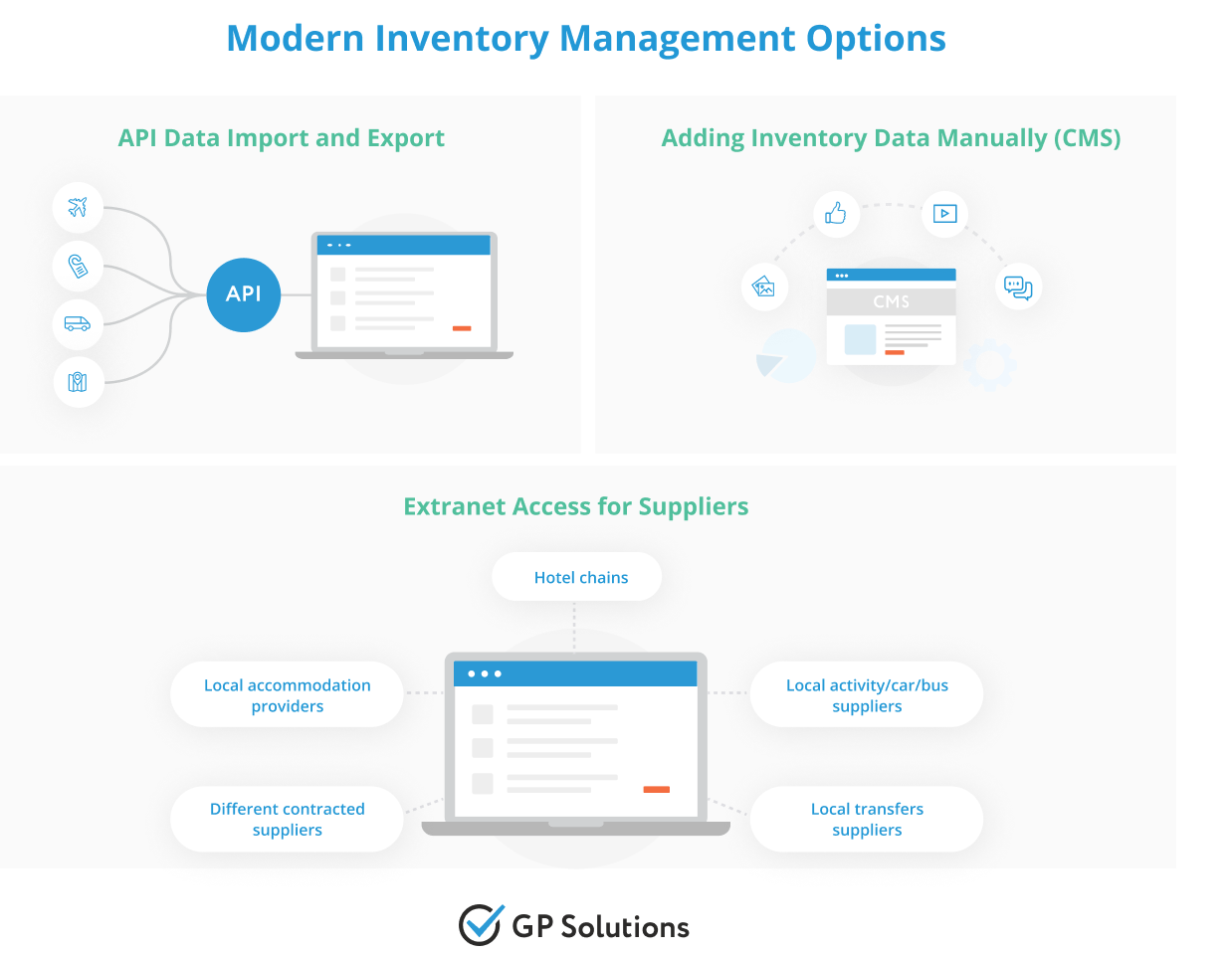
This functional block contains a set of means to store and process all incoming booking requests by assigning them to responsible individual managers or teams. It also contains sophisticated filtering and listing capabilities allowing to build lists of bookings by time/date, sales channel, supplier, responsible manager/service team, and many other parameters. Modern reservation management is able to process incoming booking requests in different ways:
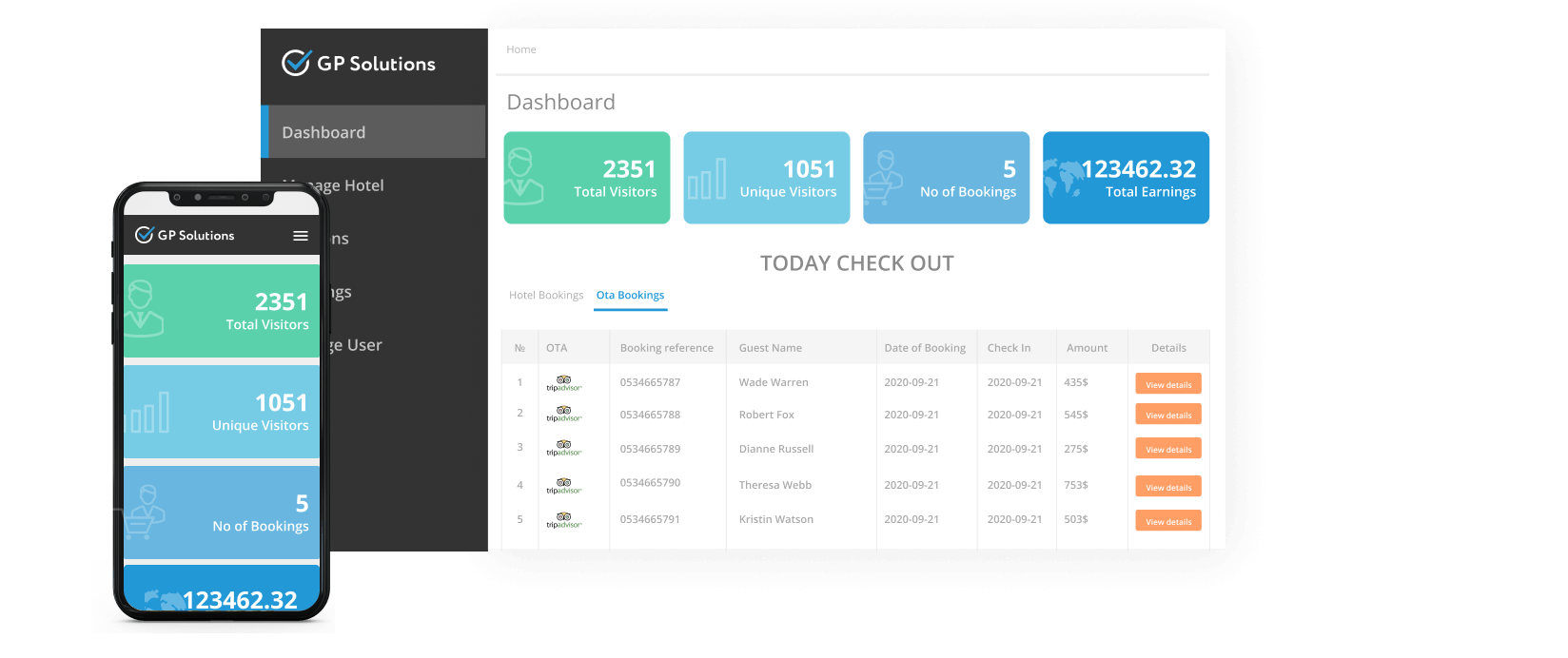
Reservation section is one of the busiest back-office sections playing a key role in effective service rendering. It is worth prioritizing this section when you are researching potential software solutions for your business.
This part of tour operator back-office covers the ways in which travel products are sold by the tour operator to various audiences. Generally, there are 2 key channels subdivided:
The B2B-oriented back-office sections may contain the following functional blocks:
Some tour operator solutions may contain sophisticated multi-level distribution systems. These serve the cause of building complex distribution structures on a revenue- or commission-sharing basis which is made up of chains of tour operators or agencies.
B2C sales segment usually incorporates diverse instruments to create customer-facing websites for selling travel services to the end traveler. Modern tour operator back-office solutions allow creating multiple B2C that can be set up for the tour operator, its partner agencies and tour operators, corporate clients, etc. The B2C is also normally equipped with an API interface that allows customers to build their own websites with unique designs and integrate them with the back-office.
B2B and B2C Interfaces of GP Travel Enterprise
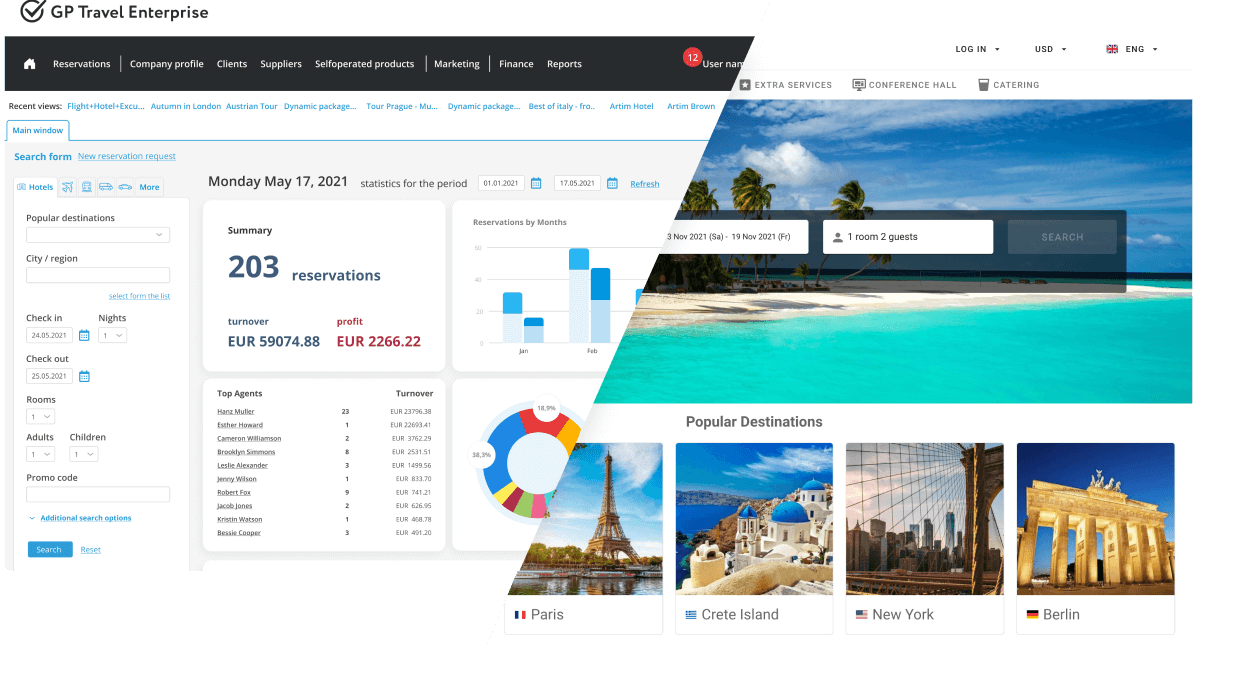
A cleverly designed and managed customer relations strategy is of key importance for any business. For this reason, customer relationship management (CRM) solutions (or just certain elements of it) are present in almost every tour operator’s back-office nowadays.
CRM solutions serve several important goals:
Tour operator back-office systems can incorporate CRM solutions differently. There can be built-in CRM modules that come as a constituent part of the back-office. However, a more popular way is to integrate back-office software with external specialized CRM solutions – the likes of Salesforce, HubSpot, Pipedrive, or others.
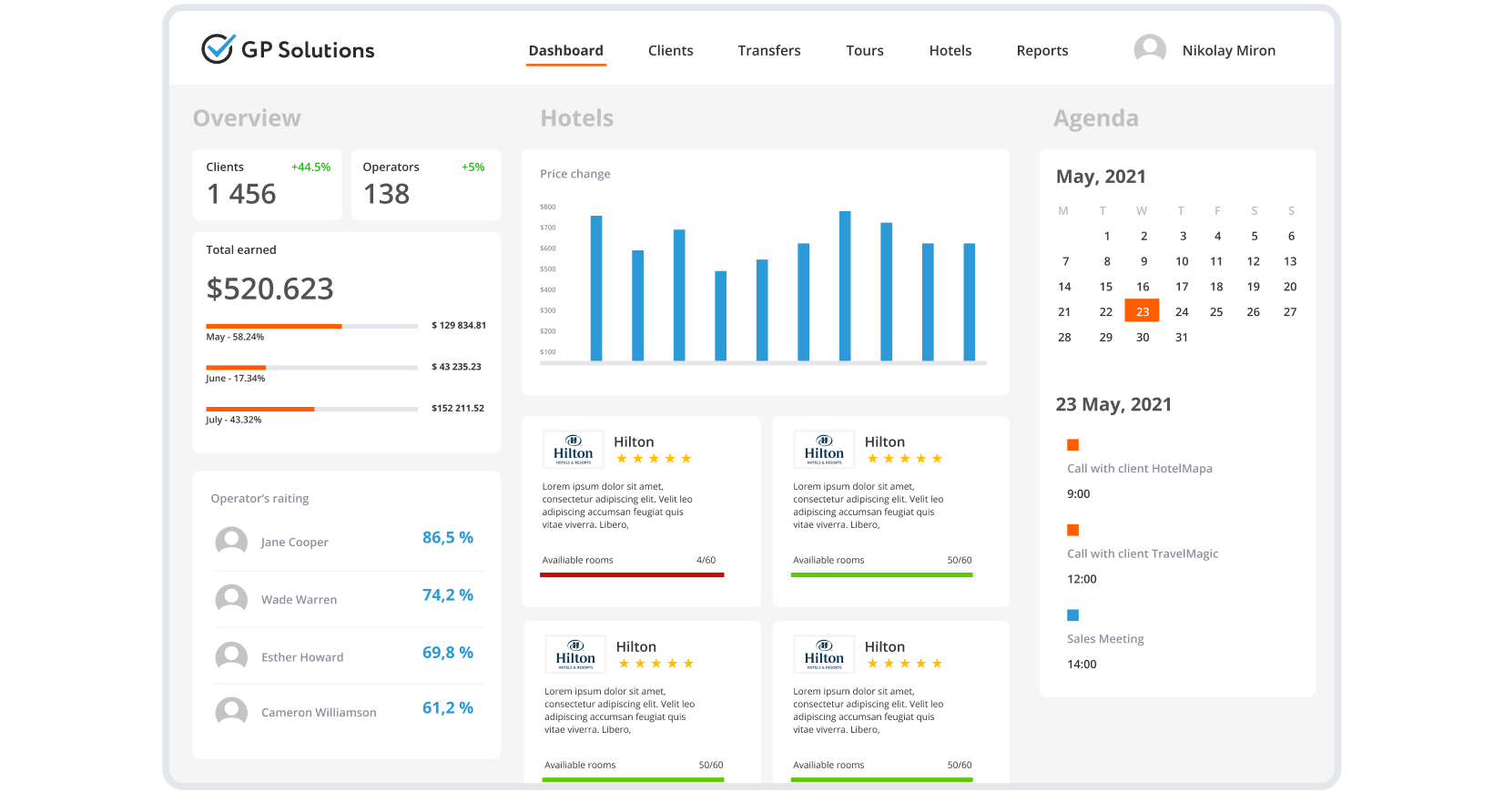
Business rules block is another important element within a tour operator back-office. Its purpose is to aggregate and govern the internal logic and commercial conditions of running tour operator business. In particular, business rules engine can be used to:
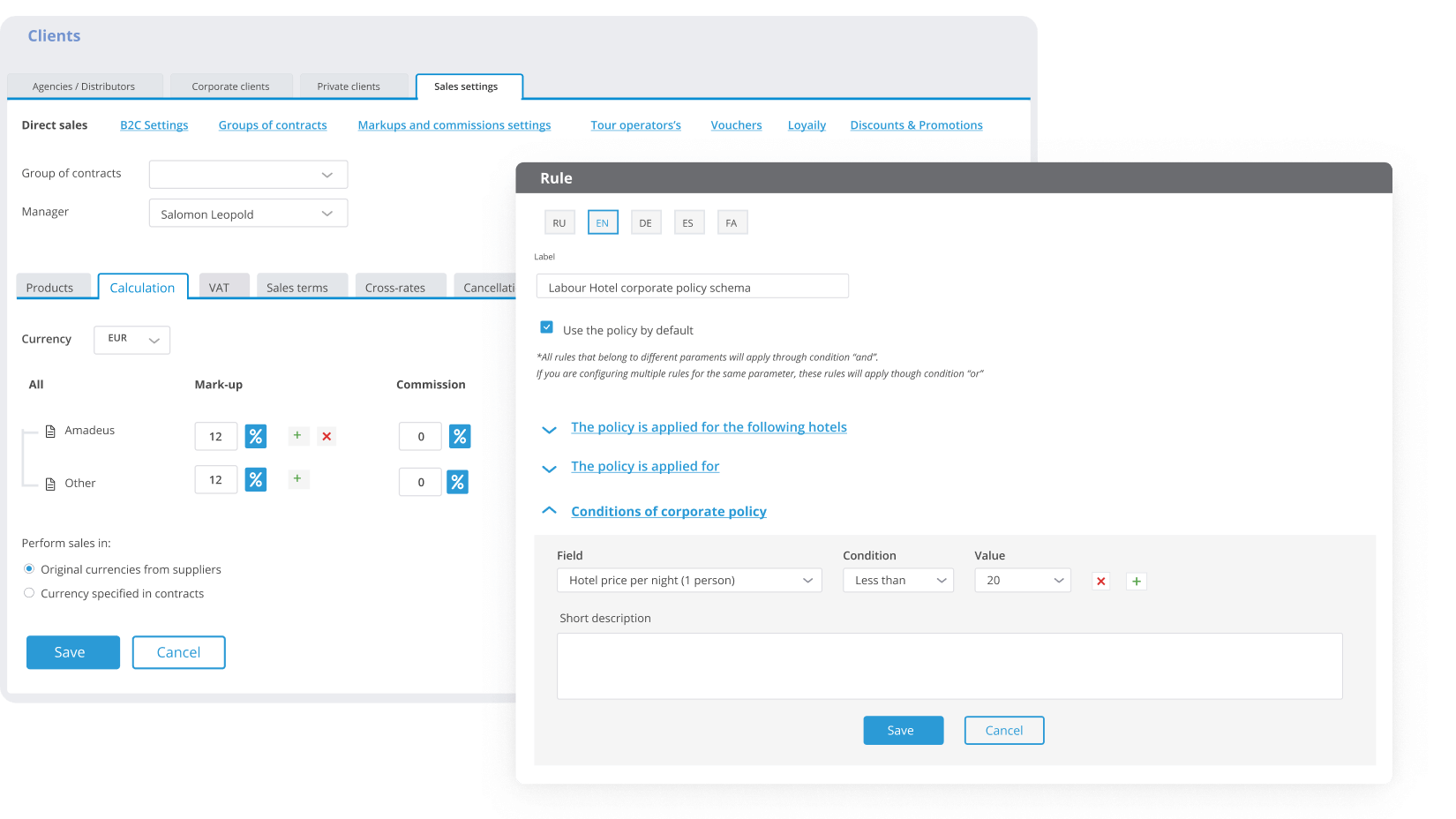
Business rules engine can be compared to what is known as ‘grey cardinal’ or a ‘shadow director’ – an invisible driving force that defines the key logic behind the entire business model.
This software segment serves to track financial operations and acquire complete information regarding the tour operator’s financial flows. It normally involves the following items:
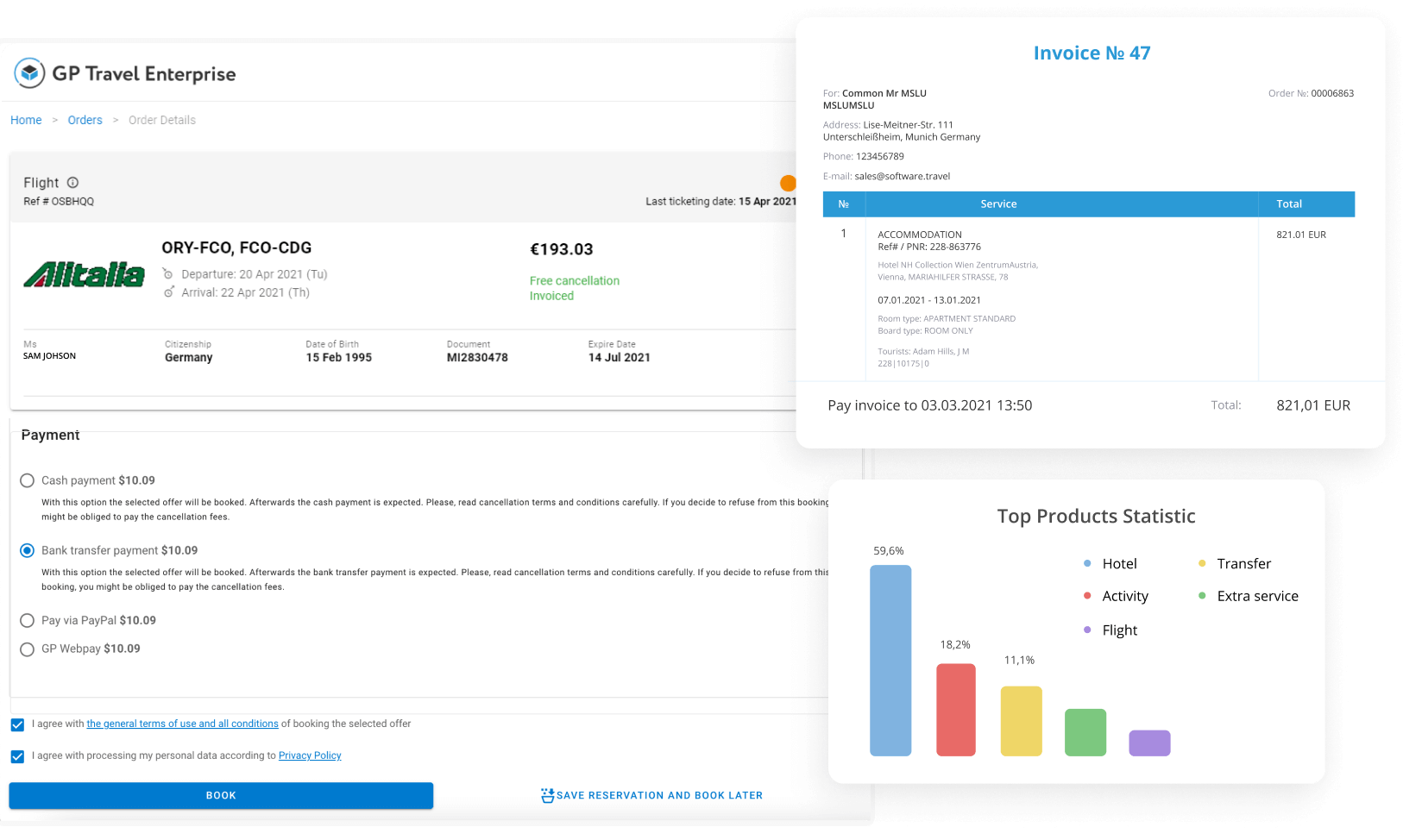
Own accounting is available to this or that extent in any tour operator back-office. But the common practice nowadays is to also connect specialized accounting software like Sage, Xero or other systems for the purpose.
It is of vital importance for the tour operator to provide adequate means and conditions of payment for the travel services provided. All activities associated with setting up payment methods and conditions are usually handled within a specified back-office section. It usually contains options to configure:
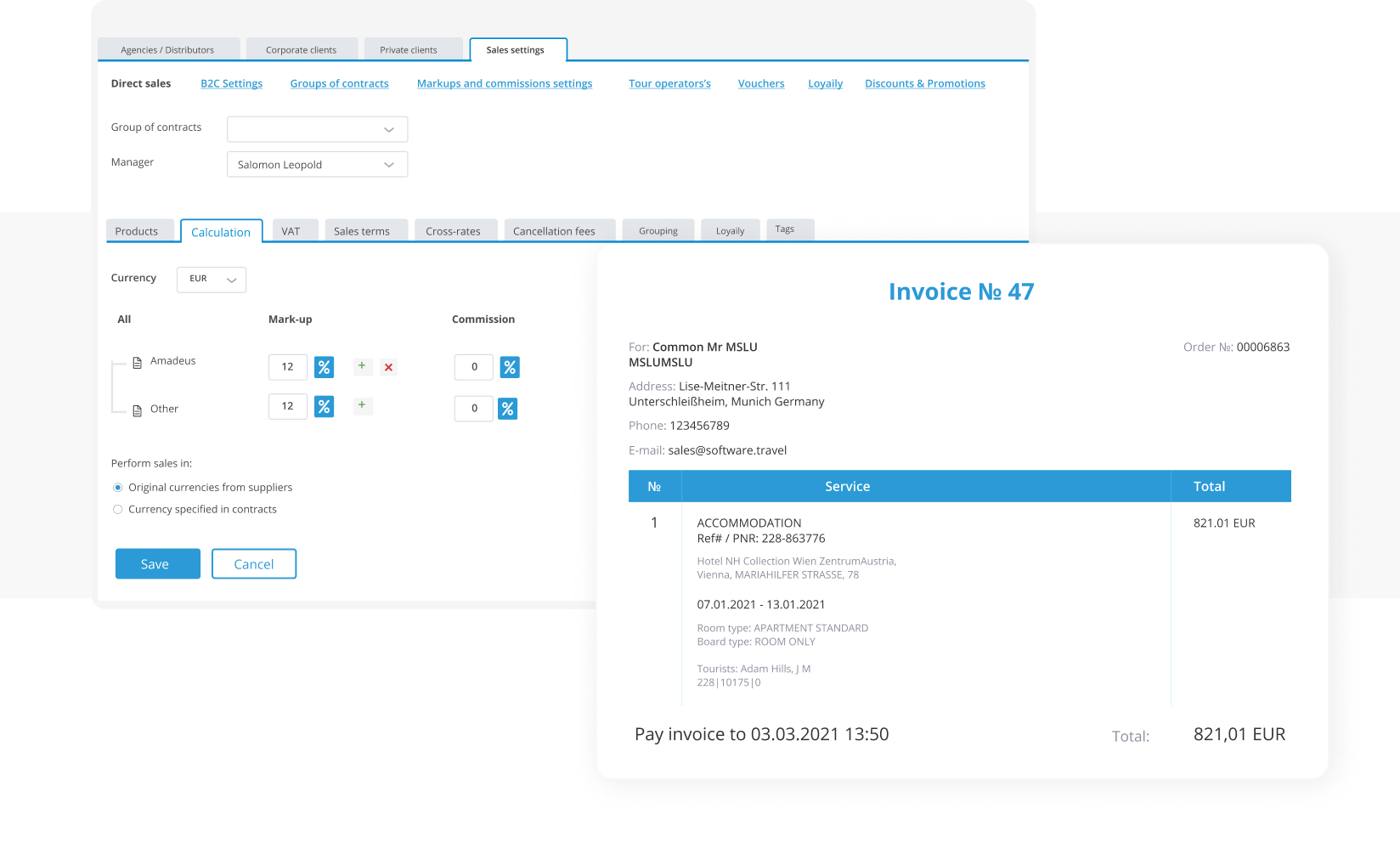
This functional block grants the tour operator full control over the sales status and company performance. It can provide tour operators with instant and exact information on the number of orders made by any given agency and from any given supplier, build reports on the most booked destinations, travel services and much more.
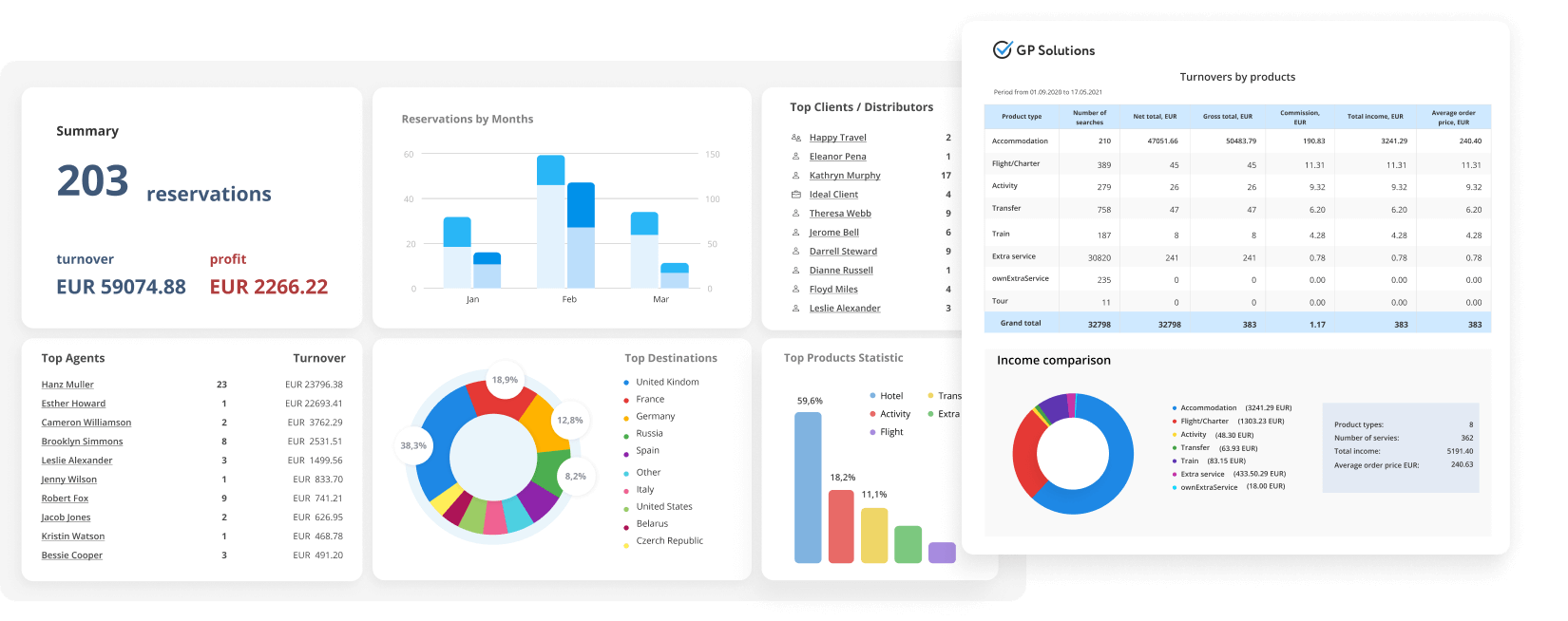
Modern analytics in tour operator back-offices can be built-in or also connected from a specialized 3rd-party vendor (for example, JasperReports, Microsoft PowerBI, HubSpot, FineReport, etc.). The latter are normally a lot more sophisticated and are powered by the latest advances in BI and Big Data to offer top-notch stats and analytical data.
Analytics functionality is one of the most important elements influencing decision-making of tour operators with live data on business performance.
Modern tour operator systems involve a whole world of different users responsible for their own bit of work within the company’s structure: managers, administrators, guides, suppliers, agents, corporate clients’ employees and many more. It is important to provide them with adequate permission rights to enable them to perform their own bit of work effectively and without intervening with the activities of their colleagues. A separate user management section is normally provided for this purpose. In addition to permission rights settings it normally provides instruments to:
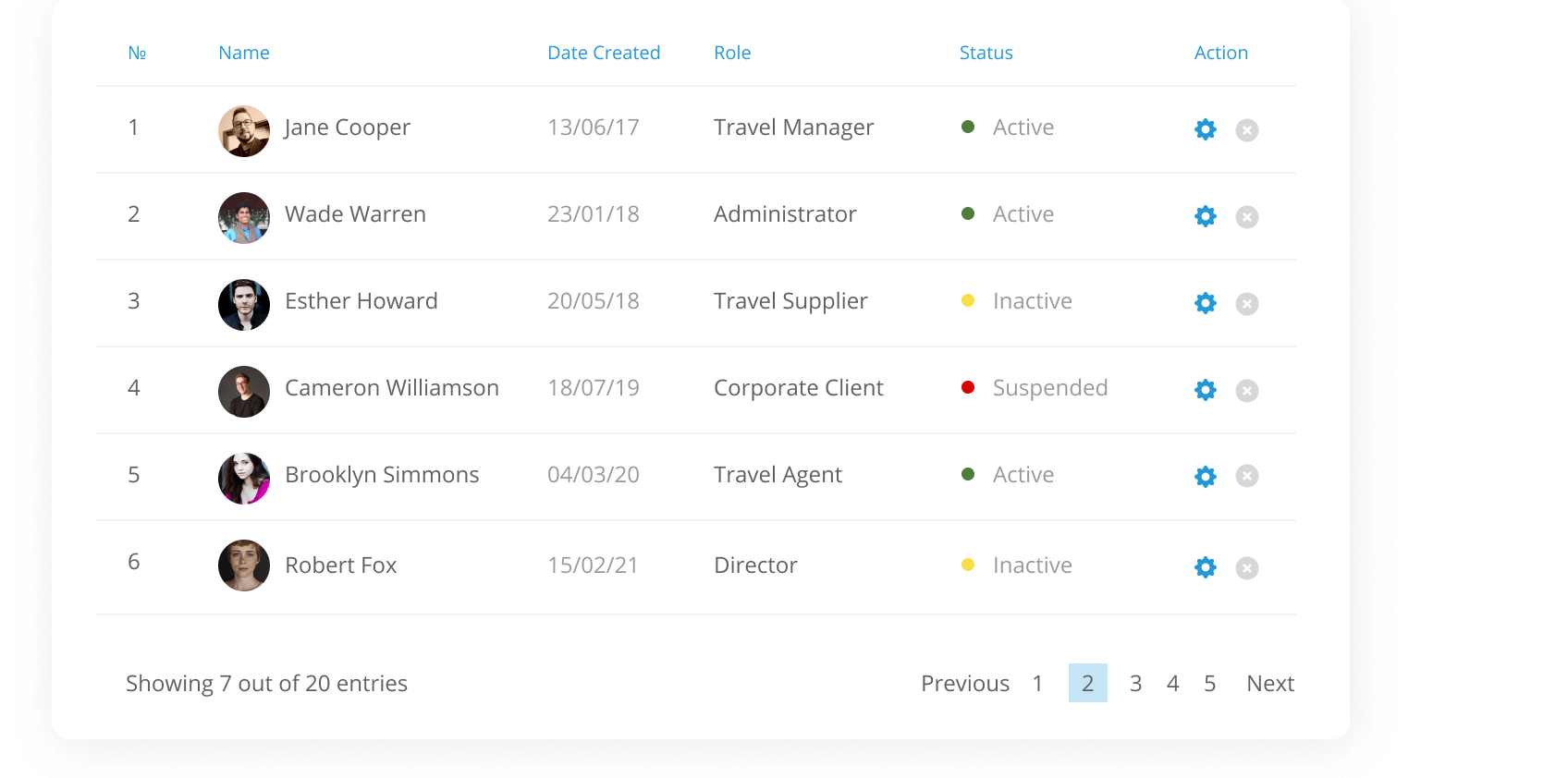
Thus, the user management section provides a unified point of supervision over users making it easy and convenient to execute supervision of their activities.
Adequate and professional customer care is a major prerequisite for strong business performance and building a loyal client base. Modern back-office systems are equipped with various modules and tools to ensure high-quality customer service. The most frequently used ones are:
Combined they help to ensure quick response times and effective processing of customer requests, which leads to better client retention rates, improved engagement and higher sales.
It is noteworthy that tour operator back-office systems may have significant differences in setup depending on what kind of tour operators they are built for.
These companies predominantly specialize in arranging trips abroad. For this reason their inventory will not require an extensive CMS designed for creating self-operated products. Most of their bookings come via contracted 3rd-party suppliers, which means their back-office has a well-built section for 3rd-party integrations and Extranet to fill the inventory from external sources.
Outbound tour operators often sell a wide selection of travel products. For this reason a back-office setup for them will normally include several activated APIs by product type with multiple API connections to different wholesalers, GDSs, aggregators, etc.
Tour operators of this type normally specialize in one particular destination and work with a limited set of local service suppliers. They also tend to focus on highly customized experiences with hand-crafted itineraries. Because of this their back-office setup will have the following distinct features:
These companies focus on independent travellers who need the freedom and the right functionality to book travel services on their own. Thus, the back-office for these companies is normally heavily focused on B2C functionality and includes:
Tour operator software tailored to solve your Challenges
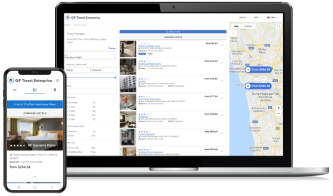
Travel technology never stands still. Software developers are constantly coming up with new and innovative ways to make tour operator software more functional, productive and user-friendly, driving better conversion rates and increased sales volumes.
At any period of time, there are clearly definable trends influencing tour operator software development across the technology market. Here is an outline for a few trends we think are the key ones at the moment.
The travel market nowadays is an ever-changing matter. New trends, products, popular destinations, suppliers change in a blink of an eye. Therefore, tour operators require flexible systems that can be easily extended or modified depending on the current market conditions. This goal can be achieved nowadays by developing back-office systems using open architecture techniques.
Open architecture is a software development approach that facilitates quick and easy addition of new programming modules to the basic development framework. It involves Open APIs (Application Programming Interfaces) allowing to conveniently extend or modify existing functionality. Open architecture allows potential users to see inside all or parts of the system without significant constraints. It makes available the key parts of the architecture that are necessary for the developer or integrator to perform his activity. This approach enables collaboration between back-office system developers and engineers on the client-side, resulting in quicker deliveries and increased customer satisfaction.
Modern tour operators are made up of multiple divisions. Each of them is responsible for its own bit of the common business. There is a vital need for these usually large companies to implement a centralized system that would accumulate business data across the entire company and provide an aggregated performance outline throughout the entire company. This is where ERP solutions came to the rescue.
Generally speaking, Enterprise resource planning (ERP) is the approach providing integrated management of main business processes, often in real-time, mediated by software and technology. ERP delivers a continuously updated view of core business processes using common databases maintained by a database management system. Tour operator ERP systems track business assets – cash flows, resources, suppliers, business capacity – and the current status of all business-related commitments: orders, invoices, bookings, payment transactions and more. The applications that make up ERP system share data across various departments within the tour operator’s structure (reservation department, sales, accounting, etc.) that provide the data.
The key benefit of ERP is the well-structured and unified flow of data between all business functions while managing relations with outside business stakeholders. Thus, it brings all tour operator departments and branches online under one roof helping the management to keep a steady hand on the wheel of the business.
Tour operators can differ from one another with respect to performed activities, business models, travel products sold, etc. At the same time, they may frequently shift their activities to enter a new promising niche – all to stay afloat and generate more revenue. Software developers in their turn tend to target a wider audience trying to meet the needs of as many travel companies as possible with their software. Therefore, they strive to develop highly functional solutions with a world of different functionality that no separately taken tour operator can swallow in full. And here comes the challenge – how do you combine flexibility and specialization sought by tour operators and the wider outreach pursued by software developers?
Modern travel tech suppliers solve this problem by developing back-office systems based on a modular architecture. It comprises a wide range of different modules which suit the needs of various tour operators – incoming, outgoing, DMCs, FIT, etc. This approach allows every tour operator to select just the modules they need for business (for ex., inventory and self-operated products for DMCs, supplier APIs aggregation for outgoing tour operators, corporate policy module for TMCs, etc.). At the same time, if a tour operator decides to make a change of focus and turn to another activity, it can quickly add new ready-made modules with minimum customization and pursue another opportunity.
Modular architecture is a win-win solution for both the vendor and the client. No wonder it is widely practiced on the travel market nowadays.
As already mentioned earlier in the text, tour operators are usually complex entities with many departments united under one roof. Each of them requires specialized software for proper automation of day-to-day activities. For example, the reservation department needs to work closely with GDSs and travel wholesalers, the sales department needs high-quality customer relationship software to define preferences and run effective marketing campaigns – so on and so forth. While being separate solutions by themselves, there is a vital need for them to regularly exchange data with tour operator back-office software for a proper data flow and centralized information storage across the entire company.
Modern tour operator systems make extensive use of real-time integrations with a world of different 3rd-party solutions – CRMs, suppliers, accounting software, payment gateways, etc. – to solve this issue. Integrations can be based on various technologies – REST API, XML/XSLT, JSON, etc. Thus, a tour operator back-office works as a hub for centralized storage and processing of business data across the entire enterprise, while the staff can meet its needs with the vast functionality offered by specialized integrated solutions.
As you may have noticed, a tour operator back-office nowadays is a comprehensive solution with multiple functional blocks and modules for different needs and purposes. It can also come in various setup versions depending on the specialization of every tour operator. Modern travel technology has advanced significantly providing in-depth automation of various tour operator activities. Essentially back-office systems have evolved into all-encompassing web-based solutions powering productive collaboration between various tour operator employees. Even remotely – a great asset during COVID-19.
We hope this small guided tour was insightful and helped you form a clear idea as to how modern back-office operates. Stay tuned – there’s more quality travel tech content coming your way!
Leave your request
We will contact you shortly
Thank you for your request!
We will get back to you as quickly as possible
Get latest insights
from our travel tech experts!
Join 200+ travel fellows! Get GP Solutions' latest articles straight to your inbox. Enter your email address below:
Thank You!